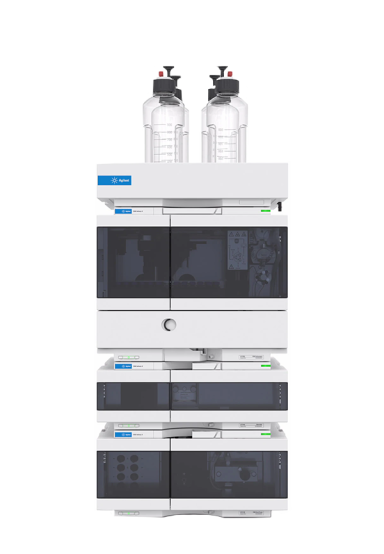
Our products
Agilent
1200 series HPLC (High-Performance Liquid Chromatography) High-Performance Liquid Chromatography. High performance means high separation capability. The HPLC device is one of the most widely used devices for analytical separation purposes. Liquid carriers are used as mobile phases for the purpose of separation of substances in a mixture. The substances in the mixture are first dissolved in a solvent and then passed through a chromatographic column under high pressure. The separation of substances takes place in chromatographic columns. The conditions that make the widespread use of the system important are its sensitivity, selectivity, ability to perform quantitative determinations, and, most importantly, the ability to separate non-volatile and temperature-stable substances. We can show amino acids, proteins, nucleic acids, carbohydrates, medicinal substances, etc. as substances that can be analyzed by liquid chromatography. HPLC is widely used in food and beverage, environment, medicine, petrochemicals, agriculture, and many other fields. Basic Parts of HPLC Mobile Phase Reservoir Pump Injector (Autosampler) Column Detector (DAD, FLD, ELSD, UV, RID and MS) Software.
Understanding Liquid Chromatography (LC)
- What is Liquid Chromatography? A powerful analytical technique used to separate, identify, and quantify the individual components of complex mixtures.
- Basic Principles: LC utilizes a liquid mobile phase, a stationary phase within a column, and high pressure to achieve separation. Components interact differently with the stationary phase, leading to differential migration and elution times.
- Types of Liquid Chromatography:
- Normal-phase LC (polar stationary phase, non-polar mobile phase)
- Reverse-phase LC (non-polar stationary phase, polar mobile phase)
- Ion-exchange LC (separation based on charge)
- Size-exclusion LC (separation based on molecule size)
Key Components of an LC System
- Mobile Phase Reservoir: Holds the solvent that carries the sample.
- Pump: Delivers the mobile phase at precisely controlled pressure.
- Injector: Introduces the sample into the flowing mobile phase.
- Column: The heart of the system, filled with the stationary phase for separation.
- Detector: Identifies and measures the separated components as they exit the column. Common detectors include:
- UV-Vis Detectors
- Diode Array Detectors (DAD)
- Fluorescence Detectors (FLD)
- Mass Spectrometers (MS)
- Software: Controls the instrumentation, and processes the collected data.
The Power of Liquid Chromatography: Applications
- Pharmaceutical Industry: Drug development, purity testing, quality control, therapeutic monitoring.
- Food and Beverage: Ingredient analysis, contaminant detection, food safety, quality assurance.
- Environmental Analysis: Water quality monitoring, pollutant identification, soil testing.
- Biotechnology: Protein purification, analysis of biomolecules, drug metabolism studies.
- Chemical and Petrochemical: Analyzing complex mixtures, refining processes.
Optimizing Your LC Analysis
- Choosing the Right Column: Consider the target analytes, desired separation mode, and sample complexity.
- Mobile Phase Selection: Polarity, pH, and additives control component separation.
- Detector Considerations: Match the detector to your analytes (sensitivity, specificity).
- Method Development: Develop a protocol for sample preparation, injection, separation, and data analysis.
Advanced LC Techniques
- HPLC (High-Performance Liquid Chromatography): Employs high pressure for enhanced speed and resolution
- UHPLC (Ultra-High-Performance Liquid Chromatography): Uses extremely high pressure and specialized columns for superior separation power and sensitivity.
- 2D-LC (Two-Dimensional Liquid Chromatography): Combines two separation modes for exceptional resolving power in complex mixtures.